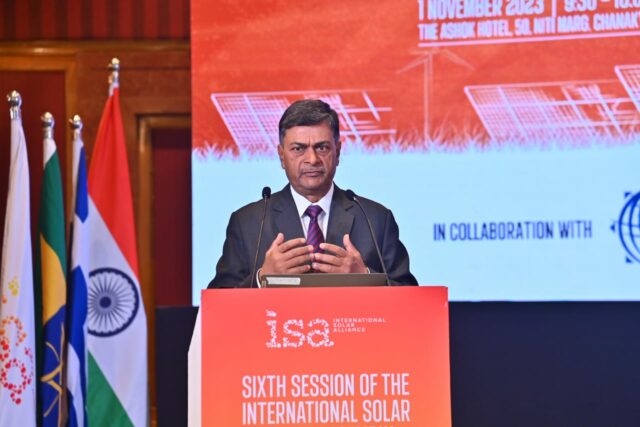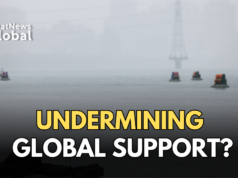NEW DELHI: The Global Solar Facility, a fund set up by the International Solar Alliance (ISA) for solar power projects in developing and under-developed nations, is likely to receive a capital contribution of $35 million, including $25 million from India.
The alliance has also decided to raise the viability gap funding for solar projects from 10 per cent to 35 per cent of the project cost, India’s Minister of Power, New and Renewable Energy and ISA president Raj Kumar Singh said at an event organised to mark the sixth assembly of the alliance.
The ISA’s viability gap funding mechanism currently provides a grant of $150,000 or 10 per cent of the project cost (whichever is lower), per country per project, and “the Assembly decided to increase the range to 35 per cent of the project cost, depending on the capacity and needs of the countries and their respective projects,” Singh said.
Flanked on stage by 20 ministers from the 116 ISA member states attending the assembly, which concludes on Thursday, Singh noted that six billion people, or almost 80 per cent of the world’s population, live in nations largely dependent on fossil fuel imports, and given the right amount of focus and funding, renewables could cater to over 65 per cent of global power demand by 2030.
There has been a spike in solar use in India since the government’s decision to provide regulatory support and there were plans to ramp up the existing solar capacity to 292 GW by 2030, from the existing capacity of about 67 GW or 16 per cent of the total output, he said.
ISA Director General Ajay Mathur said the alliance would add $10 million to the $25 million pledged by India towards the Global Solar Facility, and that it hopes to raise the corpus to $100 million soon to help mitigate investment risks in Africa and tap the region’s vast solar potential. Eventually, the GSF proposes to extend its ambit to other developing nations in Asia, Latin America and West Asia.
According to him: “Of the $310 billion invested in solar power last year, less than 3 per cent was in Africa. For this reason, much of the efforts are to increase investment in big solar plants as well as small solar micro-grids, rooftop solar, solar cold storages and so on. In the past year, we have invested in 20 solar start-ups in Africa.”
The ISA is an intergovernmental organisation co-founded by India and France after the 2015 climate talks in Paris. Headquartered in Gurgaon, Haryana, the alliance aims to bring together 126 nations that lie completely or partly between the two tropics to harness solar energy, and make the technology freely available to all nations. Apart from co-founders India and France, the United States, Germany, the United Kingdom, 111 countries from Africa to the Caribbean islands, Europe and Asia have signed up as members. However, China, the leader in the solar energy market, has not.
Quizzed on this, Singh said that “The membership of the International Solar Alliance is open to all member states of the United Nations and everyone is welcome to join.” But while “it is true that 80 per cent of the manufacturing capacity, polysilicon wafers and above, is in China, there is a need to diversify manufacturing and this was particularly apparent during the pandemic. So most countries have now set up their own manufacturing facilities.” China, however, still remains the largest player in the solar energy market worldwide by a huge margin, with its total solar panel exports amounting to more than 114 GW, one unit more than the total of 113 GW installed solar capacity of the U.S., according to one report.
The co-chair of the alliance, France’s Minister of State for Development, Francophonie and International Partnerships Chrysoula Zacharopoulou, noted that “for France, the ISA is a key initiative to promote the development of clean energy and thus combat climate disruptions. Last year, we provided over 7.5 billion euros in climate finance to our partners.”
However, she added, “The solar revolution must be backed up by a broader strategy of access to energy. I sincerely believe that this alliance has the capacity to provide solutions to one of the great challenges of our time, despite the fractures in the world.”
But while such optimism is good, challenges remain.
At the recently concluded G-20 summit in India, member states agreed to work towards tripling global renewable energy capacity by 2030. If successful, this could cut 7 billion tonnes of carbon dioxide emissions by 2030.
Globally, renewable installed capacity is currently pegged at 3400 GW, and is growing at just over 10 per cent annually. To triple that in seven years, you’d need to add at least 1,000 GW of new capacity every year. The highest ever addition of new capacity, of around 295 GW, was in 2022. Some 140 GW of that was in China alone.
The International Energy Agency, however, believes that is an ambitious but achievable target, provided there is a much stronger policy push from governments worldwide.
Apart from policy frameworks, infrastructure and skills in countries with low energy access, this would also require about $5.3 trillion per year till 2050, 20 years beyond 2030, in order to limit the global rise in temperatures to within 1.5 degree Celsius from pre-industrial times.
And even that might not be enough. Current projections indicate that greenhouse gas emissions in 2030 would exceed the 1.5 degree Celsius compatible levels by about 24 billion tonnes of carbon dioxide equivalent. Renewable energy, if tripled, would be able to avoid only 7 billion tonnes of that, or less than a third.
That is still better than nothing.
Also see:
In a career spanning three decades and counting, Ramananda (Ram to his friends) has been the foreign editor of The Telegraph, Outlook Magazine and the New Indian Express. He helped set up rediff.com’s editorial operations in San Jose and New York, helmed sify.com, and was the founder editor of India.com.
His work has featured in national and international publications like the Al Jazeera Centre for Studies, Global Times and Ashahi Shimbun. But his one constant over all these years, he says, has been the attempt to understand rising India’s place in the world.
He can rustle up a mean salad, his oil-less pepper chicken is to die for, and all it takes is some beer and rhythm and blues to rock his soul.
Talk to him about foreign and strategic affairs, media, South Asia, China, and of course India.





